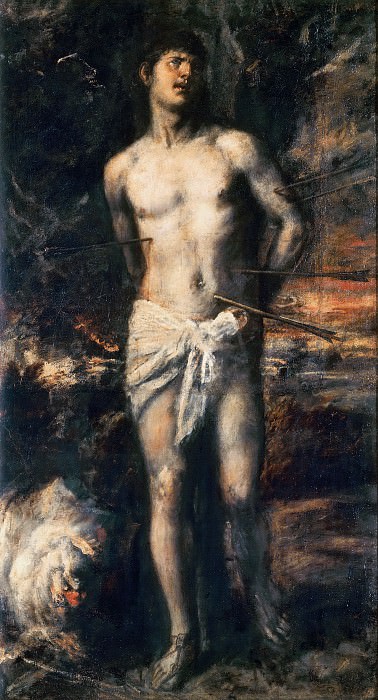Saint Sebastian Titian (Tiziano Vecellio) (1488/90-1576)
Titian – Saint Sebastian
Edit attribution
Download full size: 1882×3486 px (1,7 Mb)
Painter: Titian (Tiziano Vecellio)
Location: Hermitage, St. Petersburg (Эрмитаж).
In times dating back to the early Middle Ages, a legend circulated among the population about Sebastian, who was born in the Roman city of Narbonne. Diocletian, ruler of the empire, became aware of this young man, who had set out for Rome after completing his studies in Milan. He appointed him commander of one of his cohorts of guards. But it soon became known that Sebastian was secretly adhering to Christian teachings.
Description of Titian Vechellio’s painting St. Sebastian
In times dating back to the early Middle Ages, a legend circulated among the population about Sebastian, who was born in the Roman city of Narbonne. Diocletian, ruler of the empire, became aware of this young man, who had set out for Rome after completing his studies in Milan. He appointed him commander of one of his cohorts of guards. But it soon became known that Sebastian was secretly adhering to Christian teachings. Then the young man was sentenced to death.
The image of the great martyr, a steadfast adherent of the Christian faith, became very popular among people of art. Therefore, it is not surprising that the Venetian artist Titian portrayed him on his canvases.
The painting "Saint Sebastian" belongs to the late works of the Italian. He depicted the saint chained with ropes to a tree, giving him a majestic pose. The artist succeeded in clearly conveying the young man’s resilient disposition, maintaining composure and calmness despite the pain that was tormenting him. He understands that death will soon seize him, and accepts its coming. The light falling on the face of the condemned, as if it contradicts the feelings of the man: it is uneven and restless.
The full picture of the tragedy of the situation can be seen in the surrounding background. The nearby fire is blazing with its flames, illuminating the half-naked young man. Clouds of smoke surround his feet. The dark sky fades imperceptibly into the earth of a similar hue. The reflections falling on the terrain make it seem as if a great fire is blazing behind the saint. The rest of the world seems to die along with Sebastian.
As conceived by Titian, the painting does not represent hopelessness and despair. On the contrary, it represents the strength of the human spirit and its greatness. Saint Sebastian is not a religious fanatic who has devoted his life solely to fasting and prayer. He is a young man confronting evil.
The painting "Saint Sebastian" builds on the harmony and balance of lines and colors. It is the latter that acts as the main tool to convey the main idea of the work. As one of the researchers noted, Titian created a real symphony of colors, giving the dominant position of dark shades.
Кому понравилось
Пожалуйста, подождите
На эту операцию может потребоваться несколько секунд.
Информация появится в новом окне,
если открытие новых окон не запрещено в настройках вашего браузера.
You need to login
Для работы с коллекциями – пожалуйста, войдите в аккаунт (open in new window).




















COMMENTS: 1 Ответы
* * *
Гвоздями стрел прибит к кресту,
Которым дерево предстало.
Смерть приближает ко Христу,
А отбирает очень мало –
Всего-то жизнь, в которой зло
Непонимания Христа.
Боль Себастьяна под крыло
Берёт – бесхитростно-проста.
Он молится, молитвой жив
В ином – духовном – измеренье.
Познавший сгусток перспектив,
Предчувствует освобожденье.
Что корень замкнут был в себе –
Смерть разомкнёт, и свет подарит.
Все небо в светлом серебре –
Свет мудро в небе государит.
You cannot comment Why?